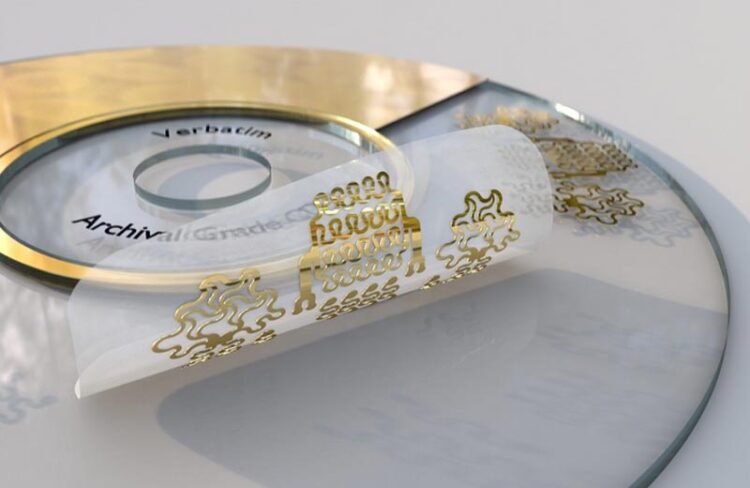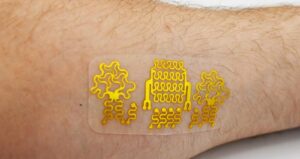Researchers recycle CDs into flexible biosensors

A gold CD’s thin metallic layer can be separated from the rigid plastic and fashioned into sensors to monitor electrical activity in human hearts and muscles as well as lactate, glucose, pH and oxygen levels.
Credit: Matthew Brown
New research from Binghamton University, State University of New York offers a second life for CDs: Turn them into flexible biosensors that are inexpensive and easy to manufacture.
In a paper published this month in Nature Communications, Matthew Brown, PhD ’22, and Assistant Professor Ahyeon Koh from the Department of Biomedical Engineering show how a gold CD’s thin metallic layer can be separated from the rigid plastic and fashioned into sensors to monitor electrical activity in human hearts and muscles as well as lactate, glucose, pH and oxygen levels. The sensors can communicate with a smartphone via Bluetooth.

Credit: Matthew Brown
The fabrication is completed in 20 to 30 minutes without releasing toxic chemicals or needing expensive equipment, and it costs about $1.50 per device. According to the paper, “this sustainable approach for upcycling electronic waste provides an advantageous research-based waste stream that does not require cutting-edge microfabrication facilities, expensive materials or high-caliber engineering skills.”
Also contributing to the research are BME Professor Gretchen Mahler; Melissa Mendoza, PhD ’22; and Louis Somma, MS ’22, as well as Assistant Professor Yeonsik Noh from the University of Massachusetts – Amherst. Nature Communications has honored the article among its Editors’ Highlights, showcasing the 50 best papers recently published in a research area.
Koh said she first considered the idea of converting the CDs into sensors while doing postdoctoral research at the University of Illinois.
“I had an idea: Maybe we could harvest the critical material from the CD and then upcycle to sensing systems,” she said. “I talked to Matt about my idea during the early stage of his dissertation research, and he wanted to continue this research.”
Brown investigated previous research on biosensors made from CDs, but he found that those sensors retained a rigid structure and had a more limited number of applications than he and Koh hoped to achieve. The first step is removing the metallic coating from the plastic beneath using a chemical process and adhesive tape.
“When you pick up your hair on your clothes with sticky tape, that is essentially the same mechanism,” Koh said. “We loosen the layer of metals from the CD and then pick up that metal layer with tape, so we just peel it off. That thin layer is then processed and flexible.”
To create the sensors, Binghamton researchers used a Cricut cutter, an off-the-shelf machine for crafters that generally cuts designs from materials like paper, vinyl, card stock and iron-on transfers. The flexible circuits then would be removed and stuck onto a person. With the help of a smartphone app, medical professionals or patients could get readings and track progress over time.
As Brown’s PhD advisor, Koh is thrilled to see something she speculated could be possible almost a decade ago is now a reality.
“I was so lucky to have Matt in the lab, because otherwise it would have stayed an idea from my postdoc research,” she said. “Some of my postdoc colleagues remember me talking about this idea to them, and they’re so excited about it.”
Brown is headed to San Diego to work for Dexcom, which makes continuous glucose monitors, but he has ideas about how the CD-to-sensor technology could be improved: “We used gold CDs, and we want to explore silver-based CDs, which I believe are more common. How can we upcycle those types of CDs with the same kind of process? We also want to look at if we can utilize laser engraving rather than using the fabric-based cutter to improve the upcycling speed even further.”
Like her former student, Koh would like to expand the CD-to-sensor research as well, possibly with the help of the campus community.
“Maybe we can create a box on campus where we could collect CDs,” she said. “We also could have more generalized step-by-step instructions on how to make them in a day, without any engineering skills. Everybody can create those kinds of sensors for their users. We want these to become more accessible and affordable, and more easily distributed to the public.”
Journal: Nature Communications
DOI: 10.1038/s41467-022-31338-9
Article Title: Upcycling Compact Discs for Flexible and Stretchable Bioelectronic Applications
Article Publication Date: 28-Jun-2022
Media Contact
John Brhel
Binghamton University
jbrhel@binghamton.edu
All latest news from the category: Medical Engineering
The development of medical equipment, products and technical procedures is characterized by high research and development costs in a variety of fields related to the study of human medicine.
innovations-report provides informative and stimulating reports and articles on topics ranging from imaging processes, cell and tissue techniques, optical techniques, implants, orthopedic aids, clinical and medical office equipment, dialysis systems and x-ray/radiation monitoring devices to endoscopy, ultrasound, surgical techniques, and dental materials.
Newest articles

Innovative 3D printed scaffolds offer new hope for bone healing
Researchers at the Institute for Bioengineering of Catalonia have developed novel 3D printed PLA-CaP scaffolds that promote blood vessel formation, ensuring better healing and regeneration of bone tissue. Bone is…

The surprising role of gut infection in Alzheimer’s disease
ASU- and Banner Alzheimer’s Institute-led study implicates link between a common virus and the disease, which travels from the gut to the brain and may be a target for antiviral…

Molecular gardening: New enzymes discovered for protein modification pruning
How deubiquitinases USP53 and USP54 cleave long polyubiquitin chains and how the former is linked to liver disease in children. Deubiquitinases (DUBs) are enzymes used by cells to trim protein…



